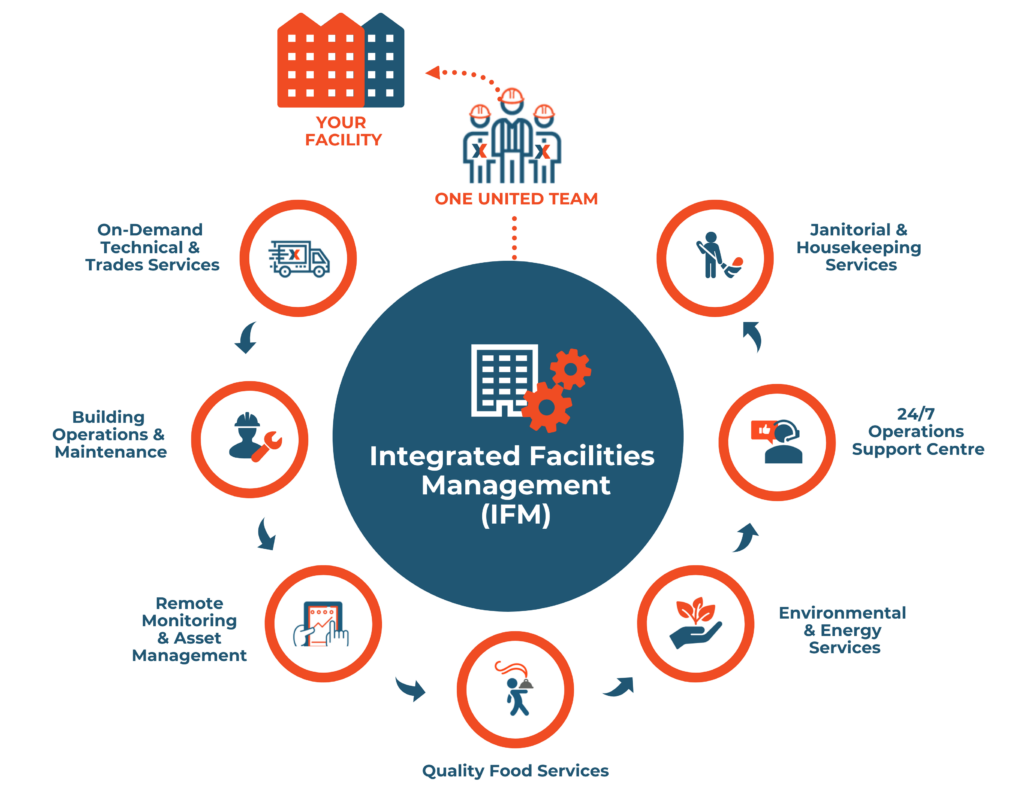Best Practices in Facility Management for Modern Companies
Best Practices in Facility Management for Modern Companies
Blog Article
Trick Trends Forming the Future of Facility Administration in 2024
As we look ahead to 2024, the landscape of center administration is poised for considerable makeover, driven by a number of essential trends. The assimilation of wise building modern technologies and a shift in the direction of data-driven decision-making guarantee to improve operational performance while focusing on sustainability in practice.
Smart Structure Technologies

Smart structure modern technologies incorporate a wide range of systems, including intelligent illumination, cooling and heating controls, and protection systems. By incorporating these systems, center supervisors can keep track of and readjust criteria in real-time, bring about substantial decreases in power waste and functional expenses. Smart sensing units can identify tenancy degrees and change lighting and temperature level as necessary, making sure that power is only used when essential.
Additionally, these innovations help with enhanced information collection, allowing organizations to track usage patterns and recognize possibilities for additional improvements. The execution of clever building technologies not just adds to sustainability objectives yet also develops much healthier work settings that can improve worker performance and contentment.
As we move right into 2024, the adoption of smart structure technologies will likely increase, showing a broader shift in the direction of more smart, responsive, and lasting facility monitoring methods.
Data-Driven Choice Making
Progressively, companies are leveraging data-driven decision making to boost facility monitoring practices. By using data analytics, center supervisors can obtain workable insights that dramatically improve functional performance and resource appropriation. The integration of sophisticated technologies, such as IoT sensors and real-time surveillance systems, enables the collection of huge quantities of data on building efficiency, tenancy rates, and energy usage.
This wide range of information permits center supervisors to determine trends, predict upkeep needs, and proactively address problems before they escalate. For circumstances, anticipating analytics can anticipate equipment failures, minimizing downtime and fixing costs. Furthermore, data visualization devices facilitate better communication among stakeholders, making sure that notified choices are made collaboratively.
In addition, data-driven approaches enhance strategic planning by enabling facility supervisors to assess the effectiveness of current practices and make informed choices regarding investments in modern technology or infrastructure. As companies significantly focus on functional excellence, data-driven decision making is positioned to come to be a keystone of effective facility management strategies in 2024 and beyond. Inevitably, the capacity to take advantage of data efficiently will empower companies to develop a lot more effective, productive, and resistant centers.
Sustainability and Eco-friendly Practices
The focus on data-driven choice making normally lines up with the growing emphasis on sustainability and environment-friendly techniques within facility management. As companies progressively prioritize ecological obligation, facility supervisors are leveraging analytics to enhance source use, decrease waste, and decrease carbon impacts. This strategic method enables the integration of energy-efficient systems, such as LED illumination, wise heating and cooling controls, and sustainable power resources into center procedures.
In addition, the application of sustainable methods extends past energy intake. Facility supervisors are promoting and taking on green materials Read More Here reusing campaigns to develop a circular economic situation within their facilities. This not just boosts the environmental account of the company however additionally promotes a society of sustainability among workers.
Compliance with ecological regulations is one more critical element driving the fostering of green methods. By making use of data analytics, facility supervisors can check compliance metrics and determine locations for renovation, guaranteeing adherence to international and local sustainability requirements.
Crossbreed Job Models
A considerable shift in the direction of crossbreed job models is reshaping the landscape of facility administration in 2024. This standard incorporates in-office and remote job, necessitating a reevaluation look at these guys of space usage, resource allowance, and staff member involvement approaches. Organizations are increasingly recognizing the significance of versatile work areas that deal with diverse requirements and preferences.
Facility managers have to adapt by applying flexible workplace designs that support joint initiatives while offering locations for focused work. This consists of the assimilation of modern technology to help with smooth communication and partnership amongst web link remote and in-office workers. Smart structure solutions, geared up with analytics and sensing units, permit real-time tracking of room use, making it possible for companies to optimize their atmospheres effectively.
In addition, crossbreed job designs highlight the requirement for effective facility monitoring that focuses on worker experience. In essence, the hybrid work version is changing center administration, encouraging a proactive strategy to fulfill the progressing demands of the workforce.
Boosted Owner Health
As organizations embrace hybrid job designs, an enhanced emphasis on resident wellness is coming to be important to facility monitoring methods. Facility Management. This shift recognizes that a healthy and balanced and pleased workforce straight affects productivity and retention prices. Facility supervisors are now focusing on atmospheres that advertise psychological and physical well-being, incorporating elements such as natural illumination, biophilic design, and obtainable wellness resources

Modern technology plays a crucial duty in this advancement. Smart structure systems can check ecological aspects and change settings in real-time, guaranteeing optimal convenience degrees - Facility Management. Comments mechanisms, such as tenancy sensors and employee studies, enable facility supervisors to continuously fine-tune wellness initiatives based on occupant requirements.

Conclusion
In 2024, the future of center monitoring will certainly be dramatically affected by the combination of wise building innovations and data-driven decision-making, fostering improved operational performance. These fads jointly highlight the developing landscape of facility management in feedback to modern difficulties and chances.
Facility supervisors are advertising and embracing environment-friendly materials reusing efforts to produce a circular economic situation within their facilities.A significant change in the direction of hybrid job designs is reshaping the landscape of center administration in 2024.Moreover, crossbreed work models stress the requirement for effective center management that focuses on worker experience.As organizations embrace hybrid work versions, a heightened focus on resident health is becoming essential to facility management strategies.In 2024, the future of center management will certainly be significantly influenced by the combination of smart structure technologies and data-driven decision-making, promoting improved functional performance.
Report this page